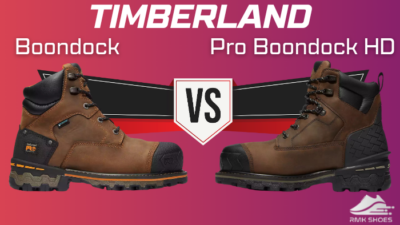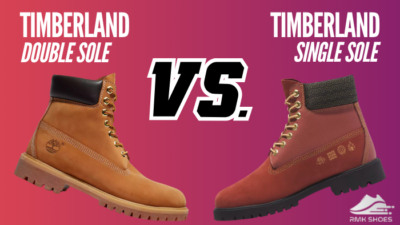Poorly fitting shoes invite some unwanted health conditions such as low blood circulation, ingrown toenails, bunions, etc.
And the most disheartening part is that little ill-fitting shoes often offer them. To reduce the miserable part, you must pick an ideal pair for you. Consider whether a larger or smaller shoe size is better for you.
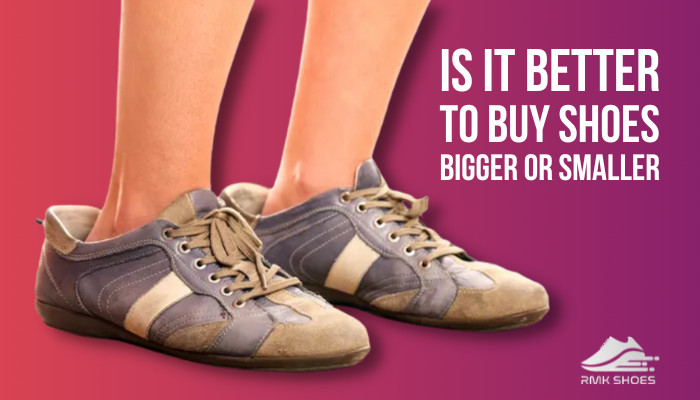
In this article, I’ll reveal all the required answers with the authentic justification that I gathered from expert advice about loose or tight-fitting shoes.
Continue reading to know each factor precisely.
Is It Better to Buy Shoes Bigger or Smaller?
Most importantly, buy shoes that offer you ultimate comfort. According to the expert recommendations, always try to pick the perfect size or a little larger for a blister-free step. If one foot is bigger than the other, consider the larger one for choosing the accurate size.
Additionally, if you love to wear socks with your boots, do not forget to wear them while you measure your feet.
The podiatrists also deliver why they prefer the bigger size because in large shoes you’ll get the proper room and the expanded space helps to breathe your feet perfectly. You can wear bigger shoes as like as you want.
On top of that, bigger shoes always offer breathable and healthy feet in all environments.
For running purposes, a half-size bigger shoe is considered an ideal shoe. To know, How the bigger shoe work for runners, please check this out.
If you already choose any specific branded running shoes for your sprinting program, before purchasing the pair, you must know the size comparison between running shoes.
How Should Shoes Fit?
Trying to get that shoes that offer the ultimate pleasure for you. You should buy a shoe that is neither too tight nor too small. Now you may think about how you know which shoe is perfect for you. Right?
So, here are some criteria to find the perfect fit:
- Measuring your feet– before every purchase measures your feet in a proper process. Our feet tend to change their size and structure due to some foot issues, such as age, weight, and exercise over time.
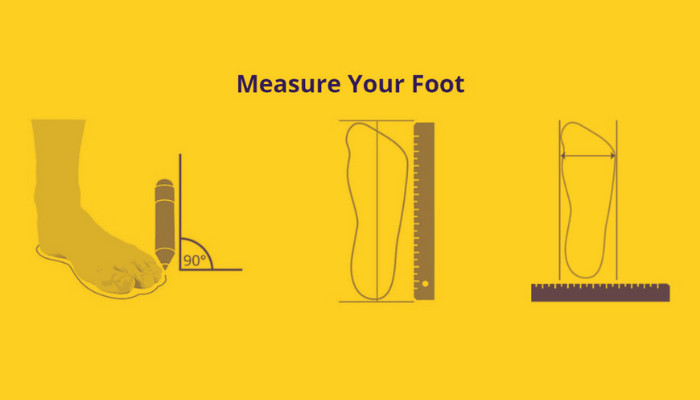
- Try the fitting of your larger feet– many of us have one foot bigger than another one. So always buy a shoe that fits your large foot perfectly.
- Trial your new pair on both feet– it’s obvious because when you have a different size, you should know how the shoe fits on both feet.
- Trial before purchasing the chosen pair– it’s the easiest way to check the fittings. After giving your desired pair a spin, you will find your answer about how it works on you during your day-long activities.
- Wear your favorite socks– try the new pair with socks if you love to wear your shoes with socks. Because if you avoid this particular step, the shoe must be snug fitting after buying and wearing them with socks.
- Evening is the ideal time for shoe shopping– usually, our feet swell the most throughout the day, and in the afternoon our feet are at their largest. So, the evening is a perfect time to purchase your cherished footwear.
If you properly follow these steps then you will get the perfect fitting shoe for sure.
Factors to Consider: Should You Buy Shoes Bigger or Smaller?
Which size you should buy bigger or smaller depends on some factors you must consider when you decide to buy a new pair.
Here are the three factors you should know to get an ideal pair:
Different Types of Shoes
Each variant of shoe fits differently. The fitting of every shoe depends on the user’s intention and the purpose they try to cover.
For example, running shoes are meant for runners. And that running pair offers the best comfort during running, which is not found in other shoes like walking or hiking. Some shoes are sturdy, some are soft, and some generally run bigger than others.
So, according to the types you have to choose the one that offers a wiggle room like crocs. There is no need to buy one size bigger.
Contrary, hiking shoes are true to size, but experts suggest for hiking a little large shoe is better than the perfect size. Because normal feet extend from their actual size while you go on a long hike. For blister-free hiking, you should select one size bigger shoe.
When you want to buy party shoes like heels, stilettos, pumps, etc. you must go with your true to size, or half size bigger. Little snug-fit pumps may invite acute ankle pain for you.
Material of Shoes
In my opinion, the material is the game-changing factor in shoe fitting. You must consider the shoe fabric while picking a pair of footwear for proper fittings.
Over time, some materials tend to become loose while others shrink. Others, in contrast, remain the same throughout their lives.
Additionally, because some shoe materials naturally grew longer after wear, you should select a size lower. For instance, after wearing, leather shoes always stretch out; conversely, canvas-soled shoes typically shrink.
As a result, you select your ideal pair based on their construction.
Depends on Season
If you’re going to purchase a pair of shoes for your summer wardrobe, you should think about choosing a pair that gives your feet room to move around and ventilation. Our feet tend to swell to excessive temperatures throughout the summer.
You should wear a size larger than usual for excellent breathability and dry feet.
Wintertime calls for thick woolen socks, which require additional room. So, when you select a shoe for your chilly winter days, you should purchase a larger shoe.
For any type of continental climate, buy a pair in your normal size.
Do All Shoe Size Change Over Time?
Yes, it’s a natural fact that the size of your shoe tends to change over time. There is a misconception for adults that their shoe sizes never alter. That one misunderstanding resulted in the purchase of the incorrect size. So, before taking any purchasing decision, measure your feet for safety.
People experience the same ailments as blisters and foot pain from the incorrect shoe size.
You feel uncomfortable due to the fitting issue, and the shoe’s edge also rubs on the back of your ankle. You can reduce the discomfort by proper and accurate fighting.
While you’re standing, walking, and going about your daily business, your feet are working hard. You also need to bring a few pairs of perfectly fitting shoes that serve your daily program.
How Do You Know If Your Shoes Fit Right?
When you are not sure whether you have chosen the right pair or not. Four simple pre-checking formulas can offer a secure purchase.
Here are the tips you must do before buying a new pair:
- Wear your shoe while buying. And walk in them and try to wiggle or move your feet. If you have easily moved your toe box and still have a large room, it’s inappropriate for your feet.
- Press your shoe top with your fingertips. Make sure you have at least half an inch between the front of your longest toe and the front of the shoe.
- Examine the area inside your footwear where you place your bottom, as well as the heel and the cups. Any spot in the toe or upper region that you find must be considerably less than your real size.
- Keep monitoring the bottom and upper, and replace your shoe right away if you see any holes or tears.
For me, it’s the top-notch criteria you must consider for your shoe fitting. There are ways to make shoes fit, It will spare you a lot of agony, time, and money.
Is It Okay to Make ill-Fitting Shoes Fit?
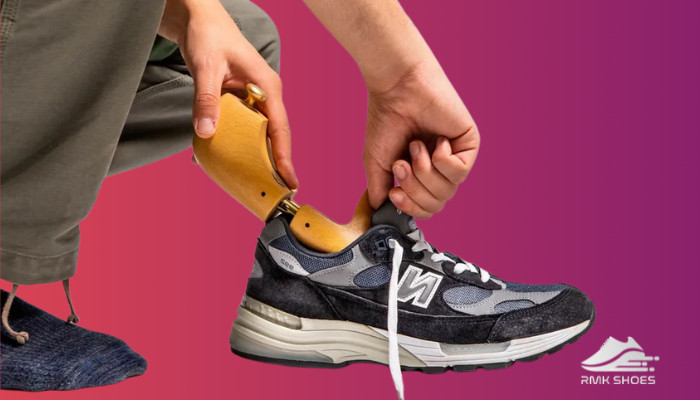
Nowadays, you can find more methods to shrink or enlarge your shoe, and they really do work well. Even though, the process takes a little time to complete and is harmful.
Do you ever consider the results of your efforts before trying to fit a shoe that doesn’t fit properly?
The shoes were expertly designed and constructed. And forcefully changing that by contracting or expanding can have disastrous effects.
While some shoes shrink with usage and time, others stretch.
But if you apply additional pressure, you will undoubtedly shorten their longevity. The pressure damaged the shoe structure, weak spots develop that may ultimately fall apart.
On top of that, you may hurt yourself by doing a tough job.
You can notice the full effects of that significant difference in how you walk, stand, and perform other tasks. Additionally, if you are unsteady during those processes, your shoe could rip and cause you to trip.
Bottom Line
There is no specification of which size you wear and how they serve you. Wear those shoes that give you the utmost comfort and offer the best adaptability.
I hope you find all the factors you may consider while buying. Moreover, continue to measure your feet at least once a year.
Whichever portion you find most appealing, please let me know in the comments. And let me know how it aids in safe shopping.
Till then, take care of your feet.

